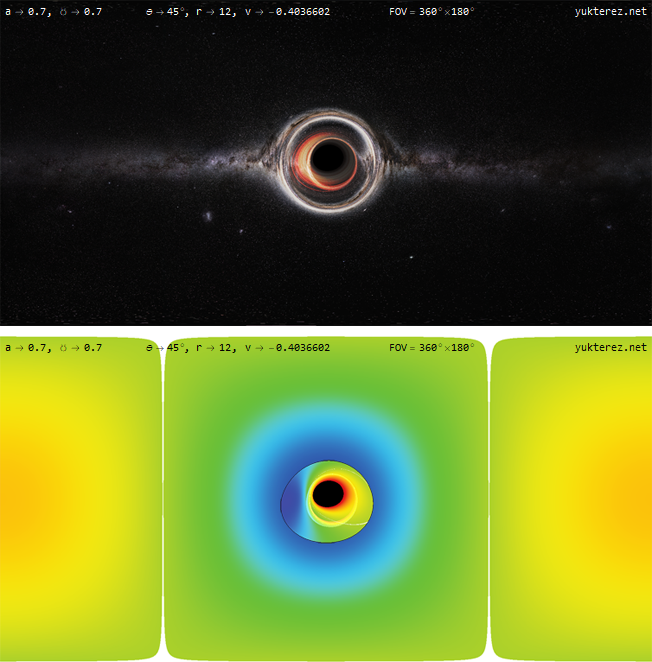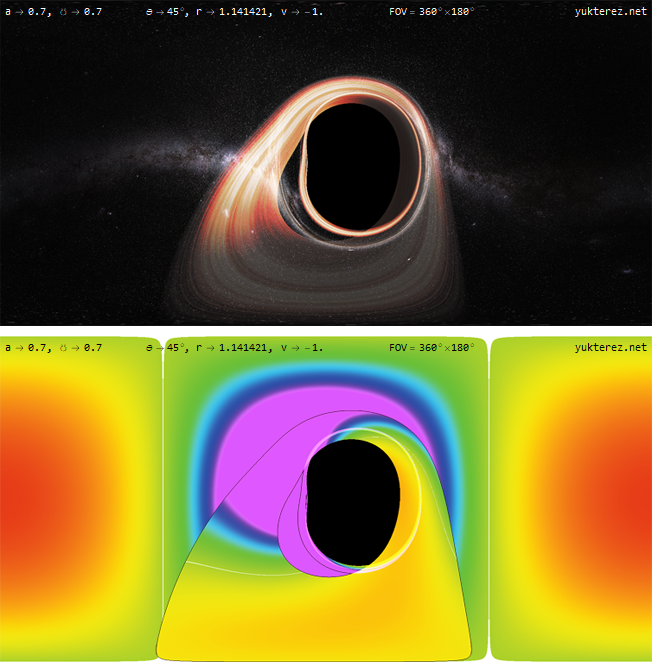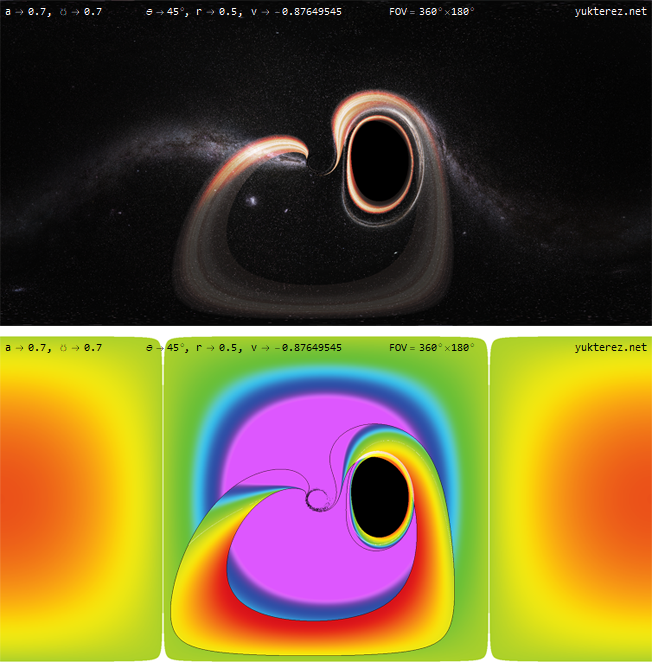What would be the view like from inside a black hole looking towards the event horizon?
Physics Asked by thokiro on December 20, 2020
Ignoring the fact that we would be torn apart by gravitational gradient and assuming we get some time to make some observations before hitting singularity, what would we see looking towards the event horizon or in any other direction away from the singularity?
6 Answers
From any direction away from the singularity that you look, you would see a circle of light that contains light that had approached the event horizon from all directions such that the incident light could have orbited the black hole at least once.
Answered by Timothy Miller on December 20, 2020
The light you will see inside the black hole it will be the light before you hit the event horizon. Does someone falling into a black hole see the end of the universe?
front view(full black) side view(half black) back view(small circle)
Answered by koolwithk on December 20, 2020
The answer to this question is covered in the book "Exploring black holes: Introduction to General Relativity" by Taylor & Wheeler (2000), within the framework of classical General Relativity.
If we are talking about a supermassive black hole, such that a free-falling observer can survive tidal forces as they approach the event horizon and the singularity, then the following scenario is presented. A star that is exactly radially outwards along the trajectory of the infalling observer will remain in that apparent position. The light from such a star is gravitationally blueshifted, but is also redshifted due to the rapid inward motion of the observer. The latter wins.
For star at an angle to a radial trajectory there is a strong aberration of their positions. As the observer proceeds (inevitably) towards the singularity, the angle they perceive these stars to be at with respect to their radial trajectory increases towards 90 degrees. In front of them, is a black circle, with a bright ring of bent (gravitationally blueshifted) starlight around it. This black circle grows towards filling half the sky. Behind them, the perceived stars "fan out" towards a 90 degree angle so that they are ultimately seen as a "ring around the sky". The final view would be that the sky is black with a brilliant ring of high energy radiation (caused by gravitational blueshift) dividing it into two halves.
You never see the singularity because all the light is headed towards it. You never (consciously) reach the singularity because you would be torn apart by tidal forces about 0.1 seconds before you get there, independently of the mass of the black hole.
Some interesting attempts at visualising this a scenario can be seen at the webpages of Andrew Hamilton, though these are not for a radially infalling observer.
Answered by Rob Jeffries on December 20, 2020
There are actually some nifty simulations that show what you would see:
http://jila.colorado.edu/~ajsh/insidebh/intro.html
(Had to post as 'answer' because I don't have enough reputation to comment)
Answered by Philo on December 20, 2020
To answer this question we have to raytrace the lightrays hitting the observer, for rotating black holes the coordinates of choice are Doran raindrop coordinates which make it possible to calculate the view from both outside as well as inside. The first image shows the outside perspective of an observer at a latitude of θ=45° free falling with the negative escape velocity (relative to a local ZAMO) v=-c√(1-1/gtt) into a rotating Kerr Newman black hole with an equatorial accretion disk whose inner radius is at the ISCO at r=1.6367 and the outer radius at r=7 (full panorama 360°×180° in equirectangular projection):
The second image shows the view when the observer is crossing the outer horizon:
In the third image we see the perspective from inside the black hole:
For different angles see here. Color code for the frequency shift:
When you fall into a nonrotating black hole, the shadow of course stays spherical, for a raytraced simulation of a free fall into a Schwarzschild black hole see the first animation in this link; when you are falling with the negative escape velocity, right before you hit the singularity, exactly half of your viewing field (180°×180°) is black.
For a stationary observer this already happens when he is hovering at the photon sphere, with the difference that the light he receives from behind would be blueshifted, while for a free falling one it would be redshifted.
When you cross the horizon with the negative escape velocity, the light that hits you from behind is shifted to half its original frequency which means the visible light would shift to infrared while ultraviolet would shift to the visible spectrum, while the light hitting you perpendicular to the direction of motion would not be shifted because the gravitational and kinematic time dilation would cancel out.
Answered by Gendergaga on December 20, 2020
The Schwarzchild-radius of a black hole is $$r_s=sqrt{frac{2GM}{c^2}}$$ everything inside the Schwarzchild-radius is invisible because nothing, not even light, can escape the Schwarzchild-radius of a black hole due to it's strong gravity.
Answered by BLM enforcer on December 20, 2020
Add your own answers!
Ask a Question
Get help from others!
Recent Answers
- Lex on Does Google Analytics track 404 page responses as valid page views?
- Peter Machado on Why fry rice before boiling?
- Joshua Engel on Why fry rice before boiling?
- haakon.io on Why fry rice before boiling?
- Jon Church on Why fry rice before boiling?
Recent Questions
- How can I transform graph image into a tikzpicture LaTeX code?
- How Do I Get The Ifruit App Off Of Gta 5 / Grand Theft Auto 5
- Iv’e designed a space elevator using a series of lasers. do you know anybody i could submit the designs too that could manufacture the concept and put it to use
- Need help finding a book. Female OP protagonist, magic
- Why is the WWF pending games (“Your turn”) area replaced w/ a column of “Bonus & Reward”gift boxes?



